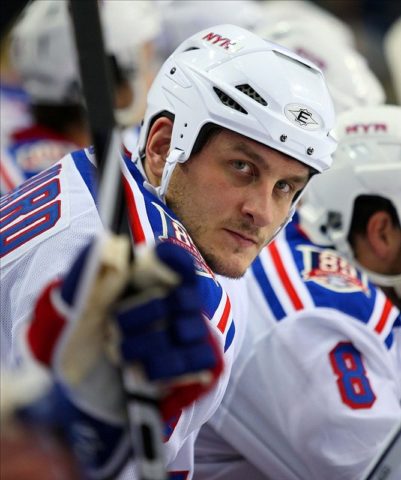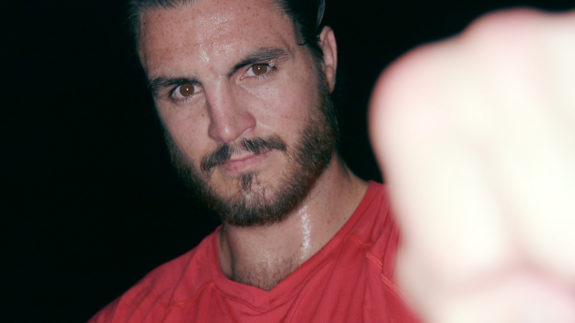Hockey may be the fastest game on earth, but Brett Harvey offers a measured meditation on the role of the slowest guys on the ice. His documentary “Ice Guardians” had a successful opening and received positive reviews. It is now on Netflix and will reach an even broader audience. It is worth watching. Probably without kids. Most hockey fans are going to have some explaining to do to their wives, partners, and kids. As the film points out, no other major sport embraces fighting with the fervor that hockey does.
There were 372 fights in the NHL last year. If that number surprises you, it is the roughly the same as there were the last couple of years. Fighting is down in general. However, the number of fights varied widely over the last decade from a high of 744 to a low of 344. Why does fighting continue? Ice Guardians explores a number of themes related to the role of the enforcer.
An Attraction to Violence
One reason is that fans like it. There is an attraction to violence that is part of us, no matter how much we would like to deny it. The film describes the “electric” atmosphere when it appears a fight is going to happen. In a fascinating moment, Jeff Marek considers his own interest in the emotional space and the slice of time before they engage and the fight begins. It is a jolt. A gut level, a pit of your stomach kind of feeling that cannot be contained by any rational understanding of the idiocy of using your fists to bash another person’s face.
The film suggests a crowd roar is different than when a goal is scored. It is primal, a way to access our instinctive nature. It is entertainment for our reptilian brain. While it may be an evolutionary holdover, sport as conflict engages old and powerful notions of good and bad. Indeed, there is a visceral joy in the power and danger of those encounters. Determining the where, when, and why is strategic. Dr. Silverwood, a criminologist who appears in the film, has conducted ethnographic research on the culture and practice of violence in professional hockey. Fights are not random.
Related: Ice Guardians: Talking With Producer Adam Scorgie
There is honor involved, etiquette, and a code of informal rules among enforcers. There is no biting or eye gouging; no hitting from behind; and no cheap shots. You never fight with someone you know is injured. It is strange somehow to hear the dialogue before and after a fight. The guys say “good luck” before a fight and “good fight” after it ends. These are professionals just doing their job. The unspoken bond among these warriors is touching somehow.
The Pain of Trying to Hold On

The film is nominally about enforcers in the NHL. It is really about the pain of failing to achieve your dream and finding a way to hang on anyway. This is the sadness that runs through Ice Guardians. The injuries and the psychic pain of waiting all day to find out who you had to fight to be able to support your family. As Geno Odjcik says “It is a hard way to earn an easy living.”
While addiction isn’t ignored in the film, there is more to be said about enforcers, addiction, and the complicity of some teams providing powerful narcotics to try and dull the never-ending pain. The film includes an interview with Derek Boogaard, who died in 2011 from a drug overdose. Boogaard’s brain has since been found to have the degenerative brain disease CTE. Dr. Charles Tator, a world-renowned concussion specialist provides a useful and accessible way to understand traumatic brain injury. It is a risk associated with many sports and one which appears connected with substance abuse. The New York Times reported that in his final three seasons playing in the National Hockey League, Derek Boogaard received more than 100 prescriptions for thousands of pills from more than a dozen team doctors.
The Role of the Enforcer
Through the film, Brett Harvey makes a case for the role of an enforcer. In sum: fighting or the threat of a fight mitigate more serious violence. In a game that is so fast, there is a significant danger that when cheap shots and dirty play become part of a team’s tactics, players suffer. The film compares Sidney Crosby’s multiple concussions to Wayne Gretzky, who was relatively well protected in his heyday by the likes of Dave Semenko and Marty McSorley. Indeed many skill players from Brett Hull to Mario Lemieux had a protector.
There is an important role for a protector/enforcer in social groups. Howard Bloom, a human behavioral specialist cites research on groups and group behavior that suggests groups tend to sort themselves to play essential roles. While the notion of a protector existed as far back as the 1920s, the concept of enforcer can be traced to the 1970s and 1980s and the expansion of the league. More teams meant more players. More players meant room for tougher players. The Philadelphia Flyers during the “broad street bullies” era took the intimidation game to another level. This led to an arms race and the center ice fight, and staged fights of the 1990s, where announcers gleefully introduced a “super heavyweight bout.”
It’s Not Them, It’s Us
The film includes commentary that suggests that the first hockey game ever recorded ended in a bench-clearing brawl. Indeed, enough players, fans, and folks begrudgingly admit there is a role for fighting in the game. Indeed the film provides a justification for fighting that most fans that hate fighting can’t easily dismiss. If we want speed and skill, we need to make sure those players have room to play. If the refs can’t see or won’t call dirty shots, someone else is going to have to step up.
As the speed of the game increases and the competition for roster spots becomes even tougher, it is hard to see how enforcers can stay in the game. While fighting remains part of the sport, it is not as celebrated as it once was. Gone are the bench-clearing brawls.

Since 2011, the league has focused on cracking down on boarding and checks to the head, and former players like Ken Dryden have published Op/Eds calling for zero tolerance for such infractions. (from ‘Debate Sharpens Over N.H.L. Safety Rules and Fighting,’ NY Times, 10/12/2011) This year, the league is tightening up on slashing, and there was an unprecedented number of penalties called in the preseason. For those who complain that such an approach to refereeing destroys the game, consider the alternative. If NHL referees won’t call cheap shots, enforcers will be forced to mete out their own justice.
A Film of Contradictions
You don’t have to love fighting to respect those who were forced to make their living that way in the NHL. Viewers may feel conflicted that they try to square their revulsion at fighting with their respect for those who battle night in and night out to protect their teammates and contribute as best they can to their team.
Other contradictions exist as well. The NHL is far behind other sports such as baseball and football in popularity. While fighting is a fan favorite, it limits the family-friendly appeal of the sport. Likewise, those who are asked to play the role of enforcer describe in excruciating detail the physical, psychological and emotional price they paid. At the same time, watching them recount their experiences, it is hard not to conclude that they seem to have enjoyed every minute. The final contradiction is that even those who dislike fighting, are unlikely to look away the next time a fight breaks out on the ice. They may, however, feel some empathy for those who go toe to toe. They may even feel some admiration. Such is the power of this film.
‘Ice Guardians’
Director: Brett Harvey
Producer: Adam Scorgie
Running time: 1 hour, 48 minutes
* originally written in Oct. 2017